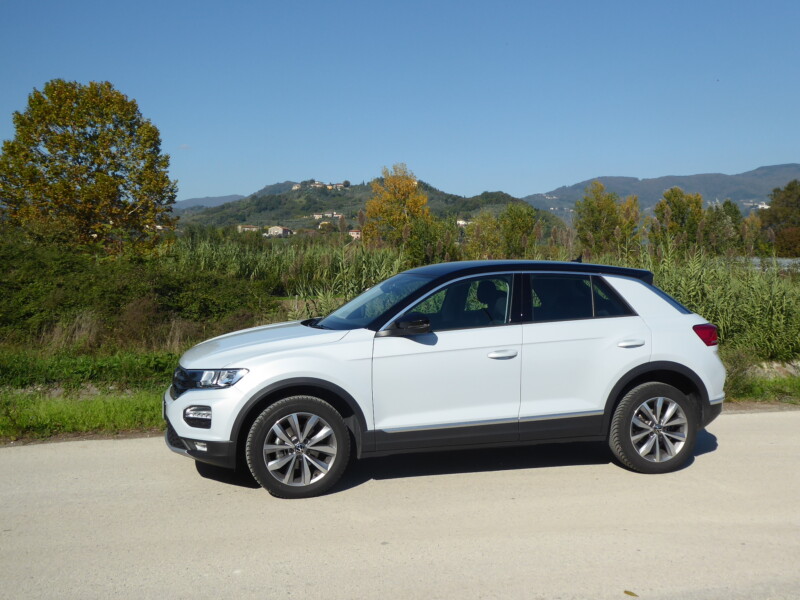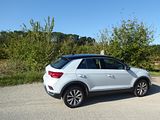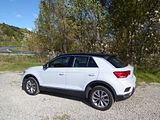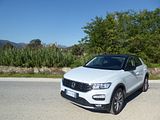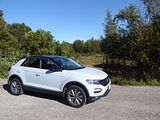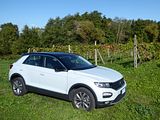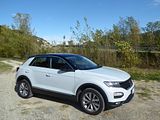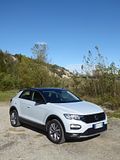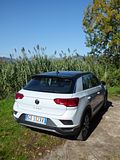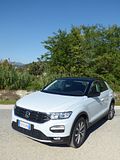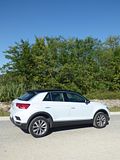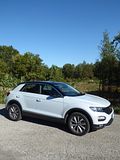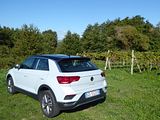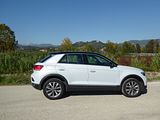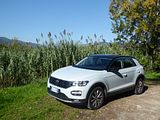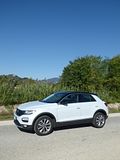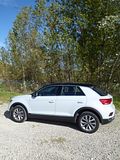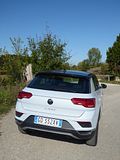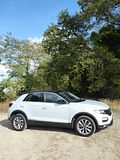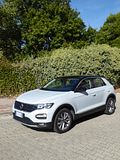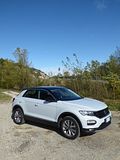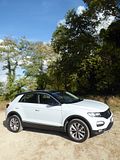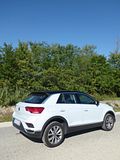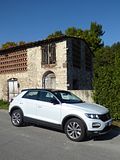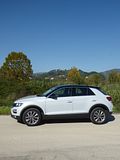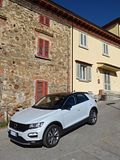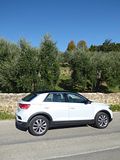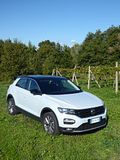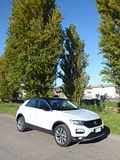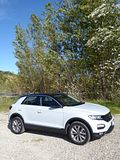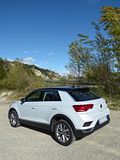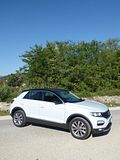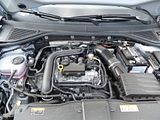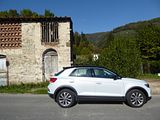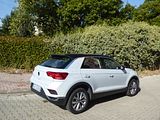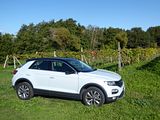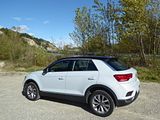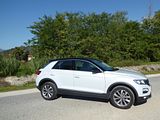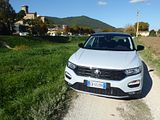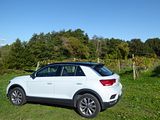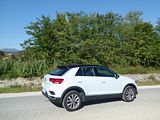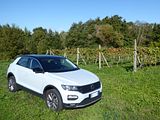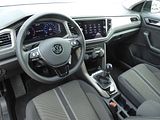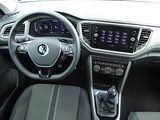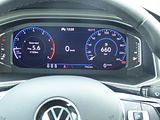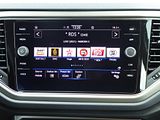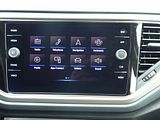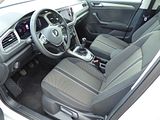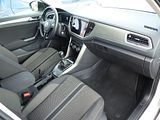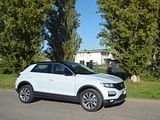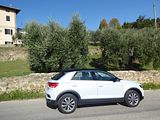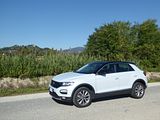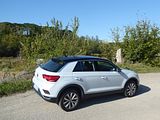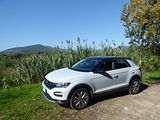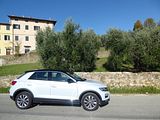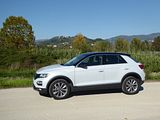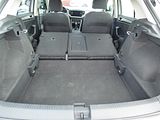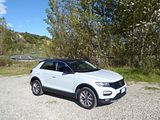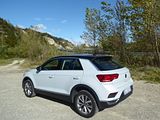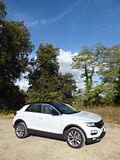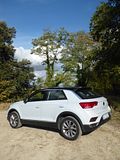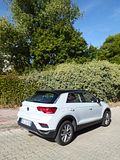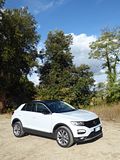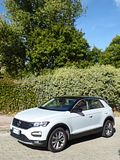The launch in 2017 by Volkswagen of a third crossover model for their European range, the curiously named T-ROC, surprised no-one. Having seen market interest in vehicles of the crossover, of all sizes, take an ever larger share of the market, it was clear that VW needed more than just the Touareg and Tiguan, especially as the second generation Tiguan had grown significantly, making more of a Passat-sized car than a Golf-sized one. The Tiguan, which has now overtaken the Golf as VW’s best-selling car on a global basis, is definitely the practical family car, the automotive version of sensible shoes, if you like, that few people are ever going to lust after, but which meets their needs so well. It’s not a cheap car, though, so I can well imagine that VW saw the opportunity to create a car that was a little bit smaller, and a little cheaper, that focused a bit more on style. The result was the T-ROC, first hinted at with a concept car of the same name which was presented at various Shows in 2014 and then with a production version which was officially launched in July 2017. Built on the ubiquitous MQB platform, the T-ROC shares almost everything under its slightly funky body not just with the Golf hatch but also the Seat Ateca, Skoda Karoq and the Audi Q2. The T-ROC aimed to set itself apart from all of these with much trendier styling, plus apparently, this car was said to be designed to be ‘fun’ to drive, an attribute that back in 2017 most competitors were claiming but almost none of them actually delivered. As well as drive dynamics, lots of effort went into ensuring that the T-ROC had substance as well as style, this model claiming class-leading levels of media connectivity and safety, plus all the potential personalisation options that buyers in this class were demanding. It was generally well received at launch and sales have been steady ever since, even in the face of a vast array of competitors. Having sampled some of these including the in-house rival Skoda Karoq, it was a car I was interested in trying, and my chance came when I was allocated one on a trip to Italy in the autumn of 2021, when covid restrictions were still making travel difficult. I was so pleased to be able to get away for a few days, but knew that an agreeable car would make things seem even better. So, the question is whether the T-ROC could do that or not. Read on.
VW launched the T-ROC with a choice of 3 petrol and 2 diesel engines, though right from the outset, diesel sales were on a significant downward trend, so it is the petrol models that received more of the focus and are the ones you are most likely to come across. All the available engines are familiar from widespread use across a whole array of VAG products, with the petrols coming in 115 PS 1.0 three cylinder, or 150 PS 1.5 and 190 PS 2.0 litre four cylinder guises and the diesels in 1.6 litre 115 PS and 190PS 2.0 litre TDI form. A potent 300PS T-ROC R joined the range eighteen months after the launch of the rest of the range. Upper spec models are available with a Haldex AWD 4Motion system, but the majority of T-ROC models will come with front wheel drive. My test car had the entry level 1.0 litre unit, with the standard manual gearbox. The T-ROC relies on a traditional key to start it. Once the engine is fired, you will be in no doubt that this is a 3 cylinder, with a characteristic sound, though this is generally quite well muted once you get underway. The car does sound quite purposeful under acceleration, but it remains civilised and feels quite refined and one up to speed, only a little wind and road noise intrudes. The car pulls strongly once you are on boost, but out of this or in too high a gear, then acceleration is lethargic indeed, so you will need to use the gears a lot. There are 6 forward gears, but the top three of these have little meaningful acceleration on offer, so you may find you need to change down a lot from a cruise if you need a sudden burst of speed. The gearchange is best described as snickety, with quite a pronounced click feeling as the lever slots into the next ratio. I found reverse very hard to engage at the first attempt, and this reminded of the recalcitrance you used to get in VAG gearboxes in the 80s and 90s, a problem they had long eradicated. There is a gear change recommendation feature which proved extremely optimistic, suggesting a change up at so low a rev point that there would just be no meaningful acceleration. Even ignoring this, I achieved some impressive fuel economy in the week I had the T-ROC. I covered a total of 1363km and it needed 75 litres so I could return it full. I covered 250km before the first bar went out on the gauge, suggesting that this was a rental car that was genuinely full when I collected it. The trip computer suggested that consumption was an average of 5.2 l/100km. If I divide my travelled distance by the fuel I put in, this works out at 51.66 mpg, which is a good figure for a petrol engine family car of this size. There is a stop/start system, and this work unobtrusively.
My over-riding memory of driving this car is the exasperating Lane Keep Assist feature which often mis-reads the road, and the resulting red alert and the noises which went with it proved very disconcerting. You can turn it off, but it resets every time you start the car. That apart, the T-ROC was quite pleasant to drive. The steering has some feel, so there was a reasonable clue as to what the front wheels were going to do as I turned the wheel, and the weight did increase a bit the more you did turn it. The T-ROC handles tidily, with understeer only apparent with exuberant cornering. There is plenty of grip and not much body roll. The test car came on 215/55 R17 wheels and on smooth surfaces, the VW rides nicely but on poor surfaces – of which there are some on the Tuscan roads where I was driving the car, it proved too firm making the car less than comfortable. I had no concerns with the brakes which worked well. There is an electronic handbrake but thankfully this proved smooth to disengage. All round visibility proved generally good. There is no rear-view camera but there are parking sensors which transmitted beeps to the central touchscreen.
If you think that Volkswagen is synonymous with a high quality interior, then you are in for a bit of a shock with the T-ROC, as whilst some things like the leather wrapped wheel feel well up to the mark, and the overall design is cohesive with good fit of the various elements, the plastics used on the dash are hard and unimpressive to put it mildly. I was no fan of the pewter plastic inlay on the main part of the dash, or the plastic piano black elements that collects fingerprints and dust in equal measure. The T-ROC was the first VW to show evidence of cost-cutting and sadly, it would seem that all subsequent models have gone in the same direction. At least the instruments are clear and easy to read. They are all electronic and you get two large dials for speed and revs, with smaller dot-style gauges for fuel level and water temperature at either end of the cluster. The central part has an extensive array of trip computer data points, which you can cycle through with buttons on the right hand steering wheel spoke. The wheel also contains audio repeaters and cruise control. The latest type of stock VAG column stalks are used, and these also do not feel to be the same sort of quality item as you used to get. The lights, with an auto feature, operate from a rotary dial on the dash to the left of the wheel. The centre of the dash is dominated by the integrated 8” colour touch screen. This includes a DAB radio but when I pressed the navigation icon, it told me the feature was not installed, which is always an irritating thing to see. You have to use the screen, or the wheel repeaters for most of the radio functions as there are no separate buttons for anything other than volume, but this was not as difficult as it can be in some cars. Below the unit are three rotaries for the dual-zone climate control.
Seat upholstery in this version is of the cloth type, with some patterns to break up the black colour of the interior, and adjustment is all manual. There is a wide range through which you can move the seats, and there is a definite feeling of space, largely thanks to the extra headroom of the crossover styling. The steering wheel telescopes in/out as well as up/down, and there are height adjustable seat belts, so it was easy to get the driving position I wanted. The seats themselves were surprisingly soft and a bit squishy but they proved comfortable, with support in all the right places.
For what is a relatively moderately sized car, slightly shorter than a Golf, there is a decent amount of space in the rear, with just about enough room for three adults. Despite the fact that the rear seats are set 46 mm higher than the front ones, headroom is still particularly generous. The centre console does stick well back, so the middle seat occupant will have to sit astride that. There is a drop-down armrest with cupholders in the upper surface and occupants here get their own air vents and a couple of USB ports. There are map pockets on the back of the front seats and bins on the doors for odds and ends.
The boot is also a good size, both deep and wide, though be warned that four wheel drive models do lose some of that depth. There is a ski flap, and of course if you need more space, then you can drop the asymmetrically split rear seats down. The resulting space is long, but it is not flat, though you can raise the boot floor to level it off with the lowered backrests. Inside the cabin there is a modestly sized glovebox, pockets on the doors, a well in front of the gearlever and a deep cubby under the central armrest which should suffice for those bits and pieces that you want to have handy in the car.
At launch, the range started with the entry-level S trim which includes dual-zone climate control, electric windows, electric door mirrors, an automatically dimming rear-view mirror, automatic lights and wipers and 16in alloy wheels. Few people were content with that, though and so most buyers wanted at last the next model up the range, which is the SE trim. This adds, among other things, 17-inch alloy wheels, chrome exterior trim, LED daytime running lights, black roof rails, variable boot floor, climate control, automatic wipers, a front armrest, a leather-trimmed steering wheel, power-folding door mirrors, an 8-inch touchscreen infotainment system including DAB, USB input and Car-Net smartphone integration, adaptive cruise control, lane assist and front assist parking sensors. Many thought that the best option to be Design. It’s not a great deal pricier than the SE, and includes all the features of that model, but also offers a wider range of personalisation options and styling add-ons, including twin chrome-effect trapezoid-exhaust surrounds and contrasting roof and door mirror colours (those tweaks tend to help bolster resale values) dual-zone climate control, front and rear parking sensors, auto emergency braking, composition Media infotainment system with 8-inch colour touchscreen, Car-Net ‘App Connect’, adaptive cruise control with Front Assist and City and black roof rails. SEL models get 18-inch sterling silver Arlo alloy wheels, LED headlights with signature LED daytime running light, Car-Net Security and Service and Guide and Inform, front and rear parking sensors, the Active Info Display that replaces traditional dials, an 8-inch colour touchscreen with the Discover Navigation infotainment system, Car-Net ‘App Connect’. The R-Line comes with bespoke exterior styling, 17-inch alloy wheels, sports suspension and silver roof rails. Inside, there’s gloss black trim in the dashboard, stainless steel pedals and selectable drive modes. VW added a 300 bhp R model to the range in early 2019 and then took us all by surprise with a cabrio version of the car in 2020. That is certainly a niche car and you don’t see many of these or indeed of the R. The R has a unique body styling kit, 18-inch Jerez alloy wheels, LED Plus headlights, and twin chrome exhaust tips. It also has four-wheel drive as standard, plus silver roof rails. Inside, the R enjoys the benefits of the Digital Cockpit Pro, leather-clad sports steering wheel with paddle shifters, and Karoso R fabric upholstery with the side bolsters finished in ArtVelours microfleece trim.
There’s much to like about the T-ROC. It goes well, in this version proved very economical, and whilst not as good to drive as a Ford Puma or a Mazda CX-30 is still not bad, ceding little in the driving experience to the conventional Golf. It has plenty of space inside it and it does look a little more interesting than some of VW’s other crossovers or indeed the car’s rivals, especially if you go for one of the style-oriented versions, and it comes well equipped. But there are downsides: it can get quite pricey, the ride is not all you would wish for and the interior quality is way below par for a VW. For some, these will be things which can be overlooked but for others, they may encourage you to look elsewhere. You are not short of choice in this sector!

